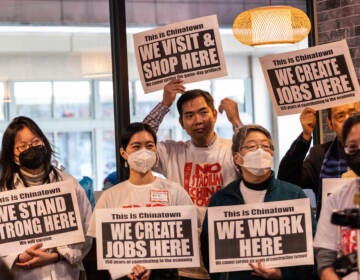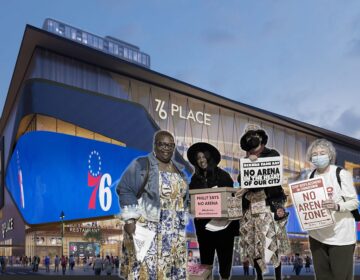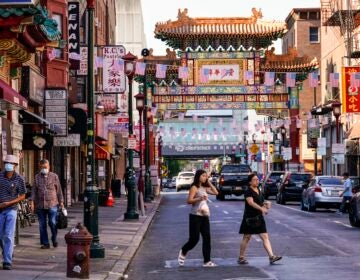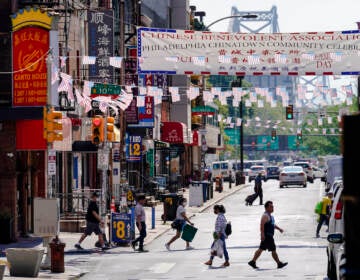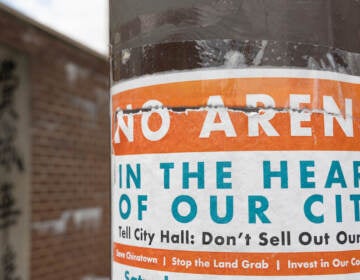‘We just want real data’: Anti-arena groups seek funding for separate economic study
Opponents argue the city’s analysis will be biased towards building a downtown basketball arena for the Philadelphia 76ers.
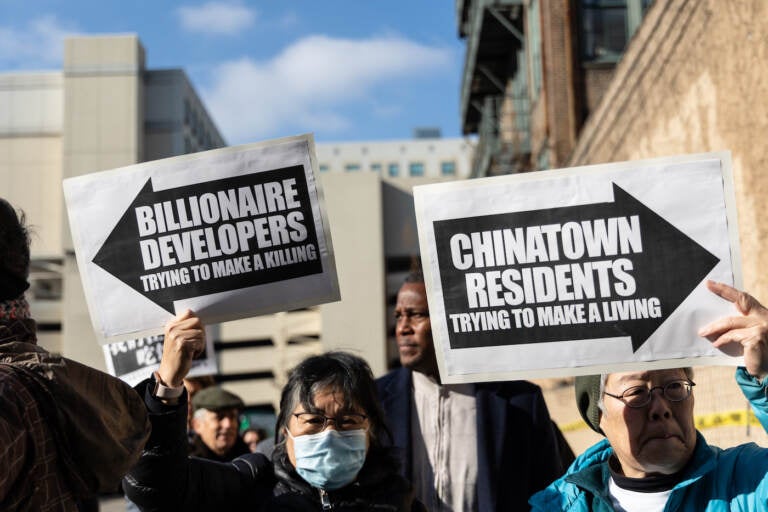
The Chinatown Coalition to Oppose the Arena walked members of the media to the site of the proposed 76ers basketball venue in Philadelphia on January 9, 2023. (Kimberly Paynter/WHYY)
Have a question about Philly’s neighborhoods or the systems that shape them? PlanPhilly reporters want to hear from you! Ask us a question or send us a story idea you think we should cover.
Opponents of the Sixers’ arena proposal have launched a GoFundMe campaign to help raise money for a study that will analyze the “true economic impact” of the $1.55 billion project planned for Center City near Chinatown.
The goal is to raise $50,000 from a combination of sources, including the online crowdfunding platform.
“It has become clear that the city’s studies are biased towards advancing the arena and helping developers negotiate. Unanswered, these studies will provide exactly the cover that developers and politicians want to use to vote yes on the arena that will cost our city more than contribute,” reads part of the GoFundMe pitch.
Thursday’s announcement comes as stakeholders eagerly await the findings of three impact studies commissioned by the Philadelphia Industrial Development Corporation on behalf of the city. Announced in April, the studies will evaluate the arena’s design, community impact, and economic impact.
Contractors include a Philadelphia-based firm that has previously worked with the Philadelphia Chinatown Development Corporation, an influential nonprofit dedicated to protecting and preserving the neighborhood. The city has also retained a Minneapolis-based company that has provided analyses for more than a dozen sports arenas, including Boston’s TD Garden, the facility the Sixers say is most similar to its proposal.
76 Devcorp, the development team behind the project, is paying for at least two of the city’s studies, raising concerns from critics that they will help pave the way for an arena on Market Street, a location the overwhelming majority of Chinatown residents view as an existential threat to the 150-year-old neighborhood.
“We just want real data,” said Neeta Patel, interim executive director of Asian Americans United, one of the 240-plus groups and small businesses part of the No Arena Coalition.
“We hope [the study] will provide information based on a larger contextual framework about what the economic impact to the city will be, what the cost to the city will be, both from scope and scale from revenue projections to impact on neighboring communities economically, so that when folks are asked to make a decision they actually know what it’s based on,” said Patel.
A PIDC spokesperson did not immediately respond to a request for comment.
A spokesperson for 76 Devcorp said the team has an agreement that gives the economic development corporation “sole discretion” when it comes to the management of the process, the selection of contractors, and the approval of any work product.
Mayor Jim Kenney’s administration has said taxpayers should not “foot the bill” for the impact studies, and echoed that the Sixers will not be involved in the evaluation process.
The studies are expected to be released this fall, and will likely add fuel to an already contentious debate about the value of building a downtown basketball arena like other NBA franchises.
The Sixers contend the franchise needs a state-of-the-art arena to be competitive — to sign top-tier players and win championships. After 27 years, the team has also grown weary of the Wells Fargo Center in South Philadelphia because it has to share it with the Philadelphia Flyers. The club insists that it creates scheduling headaches it wants to avoid in the future.
The team also argues a project of this size and scope would help revitalize the blocks east of City Hall, a disjointed stretch of shops, government buildings, and tourist attractions that have struggled to thrive for decades despite millions in investment.
The franchise is trumpeting that a downtown arena would generate an estimated $400 million of net new economic impact annually, as well as more than 3,000 jobs. The figure is based on the facility hosting events about 150 nights a year, including Sixers home games, concerts, and community events.
“This venue gets people to come downtown. I think it gets people to stay downtown and spend money,” Sixers co-owner David Adelman said during a recent interview.
The project needs lawmakers to pass zoning legislation, and likely a package of related measures, to move forward with demolition and construction. That political process is now expected to unfold early next year — after the city’s next mayor and City Council take office.
The Sixers hope to move into the new arena in 2031, the year its current lease ends at the Wells Fargo Center.

Subscribe to PlanPhilly
WHYY is your source for fact-based, in-depth journalism and information. As a nonprofit organization, we rely on financial support from readers like you. Please give today.




